Leiden, UB, BPL 88
A Martianus Capella with the hand of ‘Nisifortinus’1
This is a ninth-century manuscript with Martianus Capella’s De nuptiis Philologiae et Mercurii (The marriage of Philology and Mercury), which was at least in part probably made in Reims. In the margins, a large commentary has been copied in several hands. In the last part of Martianus’ encyclopaedia, the book on music, an insular hand added commentary material. The hand has been identified as that of the assistant of the Irish scholar John Scottus Eriugena, who was connected to the court of the Carolingian King Charles the Bald, and at his invitation head of the Palace school at Aachen from 844 on. We know the assistant under the nicknames of I2 or ‘Nisifortinus’. This suggests that the deeply secular kind of scholarship that characterizes Martianus’ work was part of the Carolingian intellectual ideal.
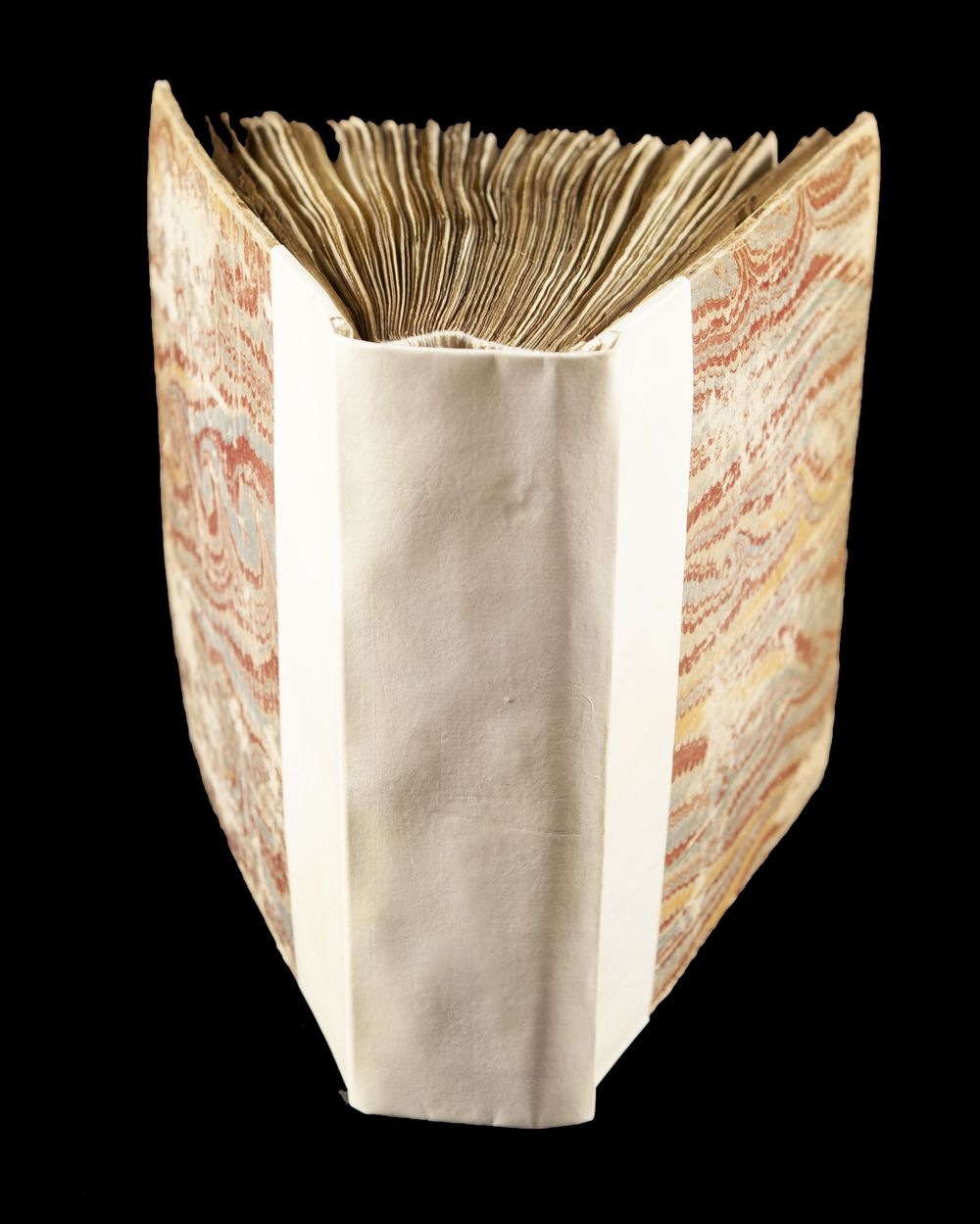
http://hdl.handle.net/1887.1/item:2028417
This is the opening of the book: fols. 2v-3r. On the right, you see the opening of the text of Martianus Capella’s De nuptiis. The script can be dated to the ninth century. On the left page, which was originally blank, a scribe entered additional texts in the eleventh century. He wrote these when the manuscript had become a part of the library collection of the abbey of Saint Peter in Ghent. It shows a continuous interest in the text.
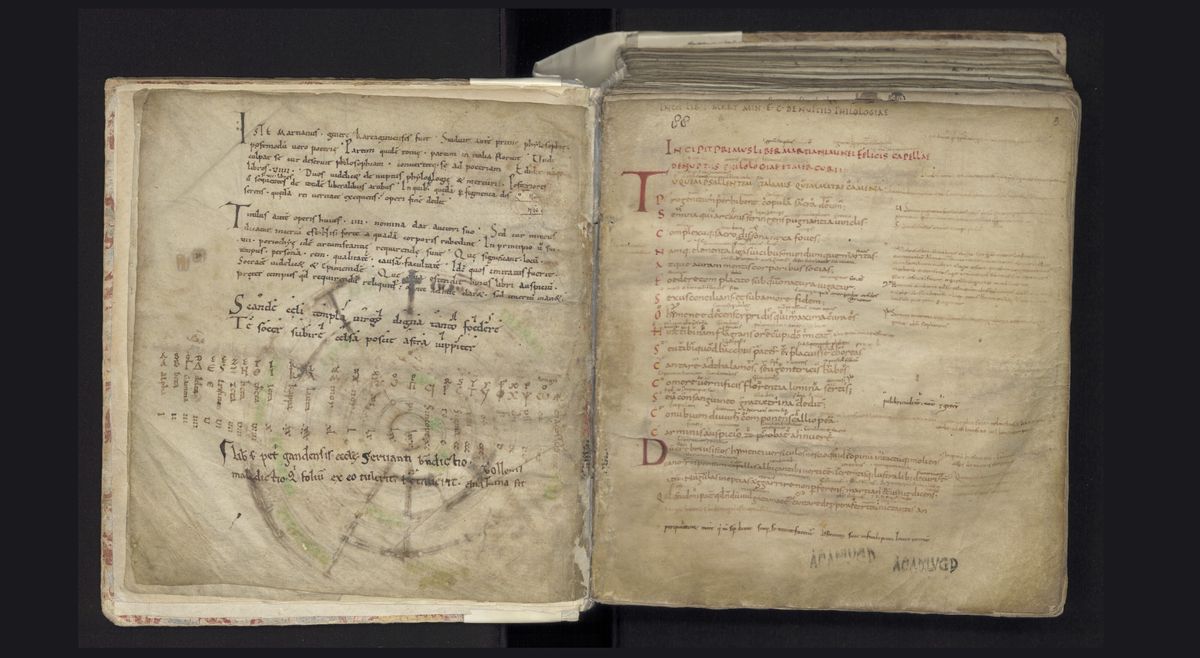

Let us look closer at fol. 2v, with the additions from the eleventh century.
The refrain “Scande caeli templa” (“Ascend into the temples of heaven”) has a melody over it, in an early music notation called neumes. (We marked it here with a green box.)The neumes indicate the contours of the melody (rising, falling), but not the precise melody. We also see (marked with a red box) a Greek alphabet, in small and capital letters, the names of the letters underneath each letter (alpha, beta, gamma …), and numerical values of each letter (1, 2, 3, …). And we see in a twelfth-century hand (marked here with a yellow box) a note of ownership and a protective curse: “Liber sancti petri gandensis ecclesie. Servanti benedictio, tollenti maledictio. Qui folium ex eo tulerit vel curtaverit, anathema sit.” (in translation: “Book of the church of Saint Peter of Ghent. A blessing to the keeper, a curse to the thief. May he who took or cut a folium from it be damned.”)
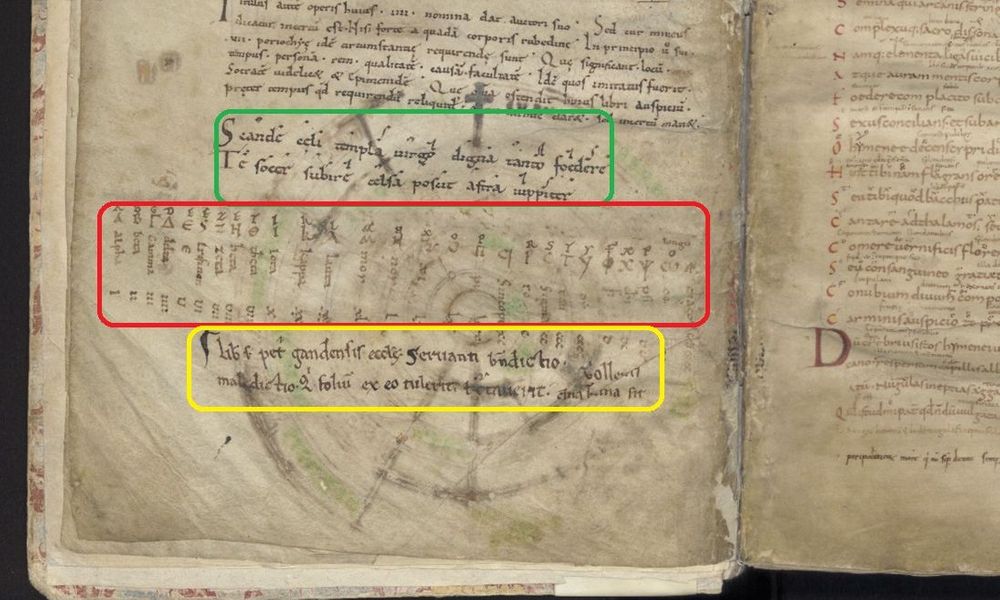
http://hdl.handle.net/1887.1/item:2028417
On the flyleaves preceding the text of Martianus Capella’s De nuptiis (fols. 1v-2r), more additional material was added in Gent in the eleventh century: a set of diagrams which illustrate the method of creating oppositions, contradictions, negations. This material is not taken from Martianus Capella’s text, but added to it to provide means to understand the art of dialectic better and perhaps practice with it.
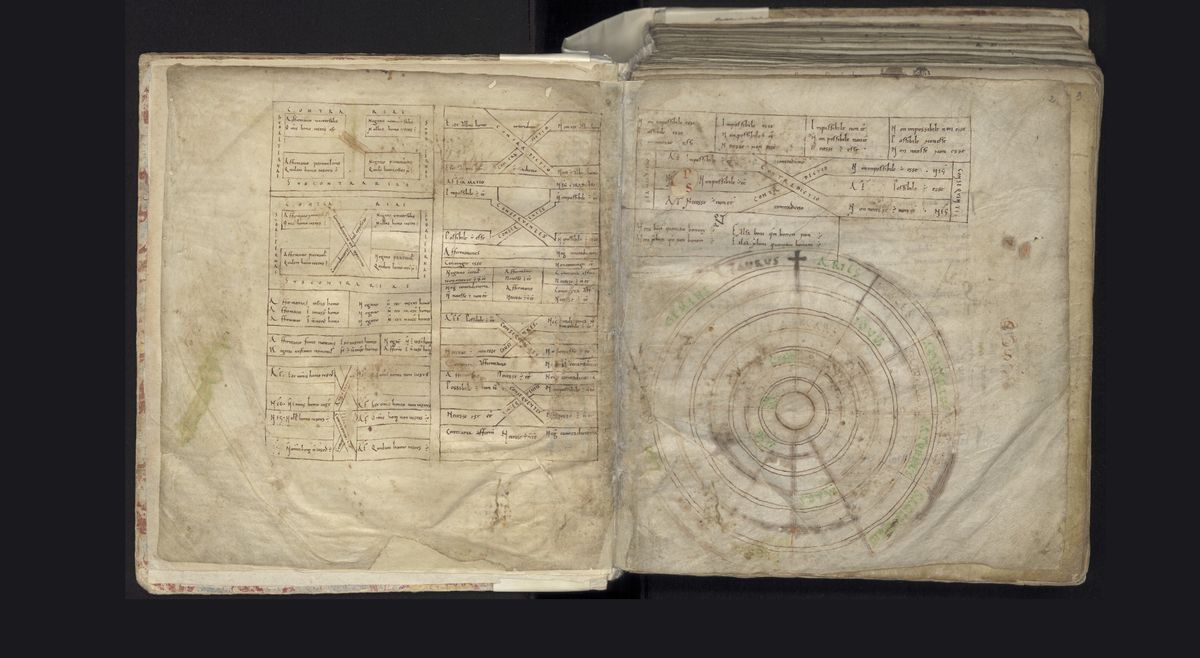

In the ninth-century part of the manuscript, we see several hands adding notes, distinguishable because of the different colours of ink and subtle differences in their writing style. Here in close-up (fol. 4v), we see a note on ‘endelichia’ or ‘entelechy’, an ancient Greek philosophical concept for that which makes the difference between mere matter and a living body.
Note how the commentator lines up the different authorities on this concept: “According to Calcidius, entelechy is perfecta aetas, completed lifetime. According to Aristotle, it is interpreted as absolute perfection. Plato, on the other hand, says that entelichy is the anima mundi, the soul of the world.”
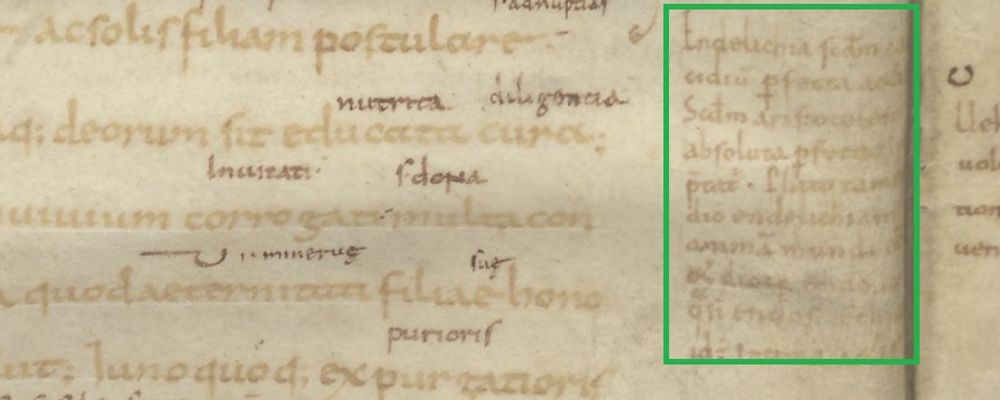
http://hdl.handle.net/1887.1/item:2028417
This is the opening of the book on Dialectic (fol. 59r). We see a mix of hands working in different colours of ink. The light ink has faded dramatically in some places. They both use an imaginative set of tie-marks, which function as markers to place the note in the margin at the proper word or passage in the main text (not unlike our own system of note numbers).
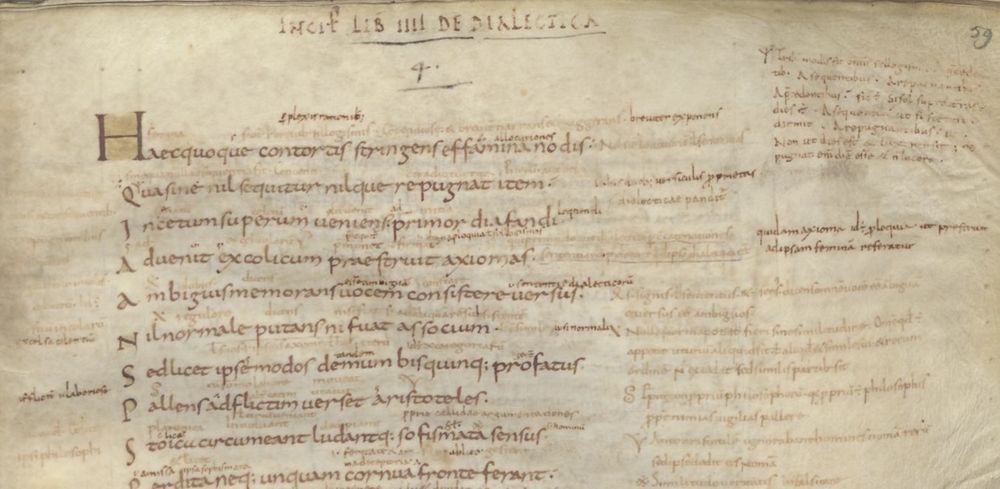
http://hdl.handle.net/1887.1/item:2028417
In the book on music in De nuptiis, a new glossing hand appears. It is the hand of the assistant of the ninth-century philosopher John Scottus Eriugena, whom we know by the prosaic name of I2, or the less prosaic, modern nickname Nisifortinus (‘He of Unless perhaps…’). He is known for his softening tone of writing when presenting his master’s controversial ideas. Nisifortinus wrote in a script known as insular minuscule. He copied long glosses into this book on music, bringing together learning found in Boethius and Augustine and comparing it to Martianus’s text. He had a strong focus on Greek vocabulary and myth.
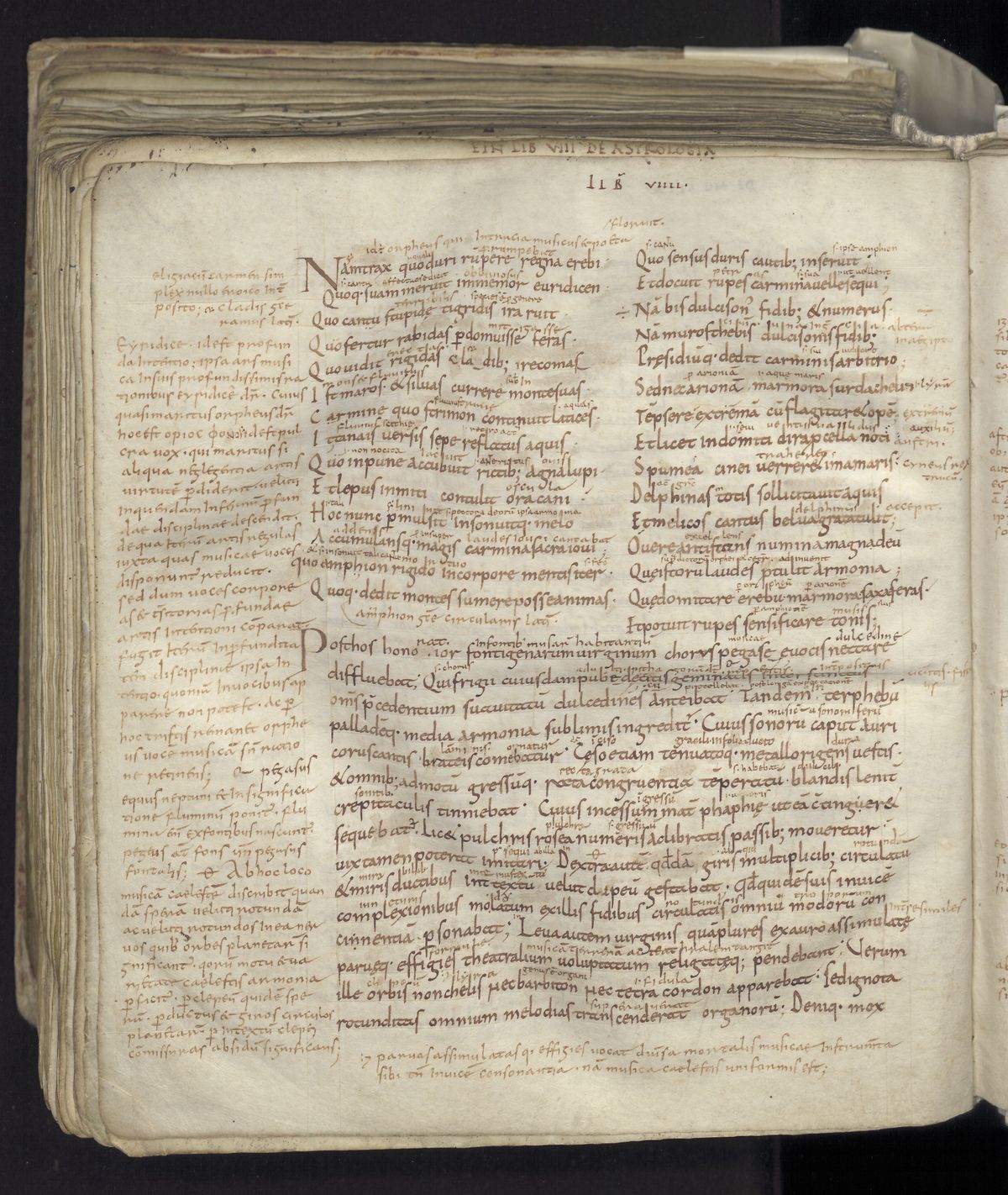

Here, in a close-up of Nisifortinus’s hand on fol. 171r, the insular traits of the script are obvious: the g has a peculiar, characteristically insular shape (also called the ‘3-shaped g’); the e extends above the line (‘e with a high hat’); the t is flat topped; the ‘flag’ of the r reaches to the writing line, so that it resembles n. It is very rare that we can identify the scribe by his handwriting: we know the individual hands of only a few medieval scribes. In this short gloss a bit of mythology is explained to give some background to Martianus’s story: “Hic tangit fabulam nam Iovis adamavit dianam et concubuit cum ea. Praemiumque ei dedit potestatem noctis luminis que eius crescere et decrescere auratis cornibus.” (“This concerns a fable. For Jupiter was in love with Diana and slept with her. As a price he gave her the power of nightly light, which she can let grow and diminish with her golden horns.”)
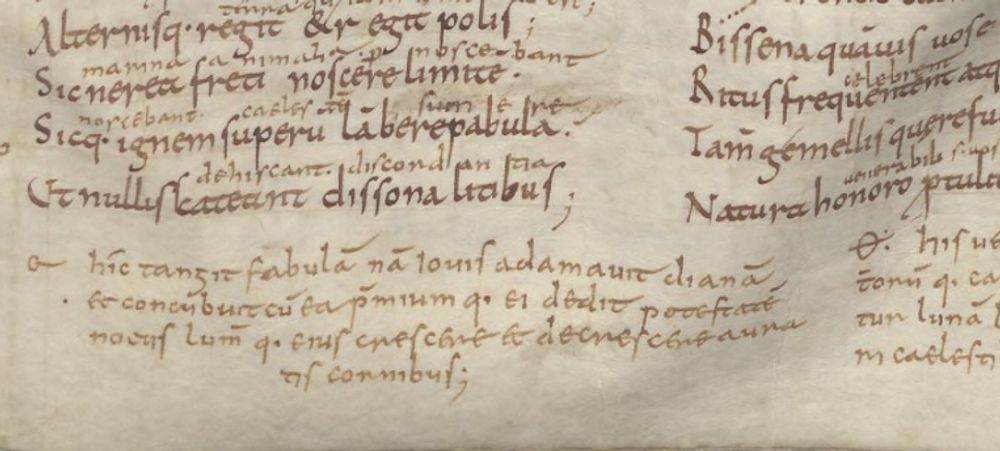
http://hdl.handle.net/1887.1/item:2028417
In this short gloss pertaining to Aristoxenos, the scribe’s interest in Greek etymology is attested. Note his use of Greek characters: “aristoxenus. aut virtus acuta aut virtus perigrina. aris enim virtus oxenos autem aut ab eo quod est oxos. idest acutus. aut ab eo quod est xenos, id est perigrinus.” (“Aristoxenus, or ‘virtus acuta’, sharp excellence or ‘virtus perigrina’, foreign excellence. For ‘aris’ is ‘excellence’, and ‘oxenos’ is either from that which is ‘oxos’, that is ‘sharp’, or from that which is ‘xenos’, that is ‘foreign’.”)

http://hdl.handle.net/1887.1/item:2028417
Sources used for this contribution:
- description and bibliography on Leiden, UB, Digital Collections website: http://hdl.handle.net/1887.1/item:1617684
- J. Peter Gumbert, Illustrated Inventory of Medieval Manuscripts, Vol. 2: Leiden, Universiteitsbibliotheek, BPL, Hilversum: Verloren, 2009, 01176-01178
- Mariken Teeuwen, Harmony and the Music of the Spheres. The ars musica in ninth-century commentaries on Martianus Capella, Leiden etc.: Brill, 2002, 117-126
- Édouard Jeaneau, Paul Dutton, The Autograph of Eriugena, Corpus Christianorum: Autographa Medii Aevi, Vol. 3, Turnhout: Brepols, 1996, 44.
Contribution by Mariken Teeuwen.
Cite as, Mariken Teeuwen, “Leiden, UB, BPL 88”, The art of reasoning in medieval manuscripts (Dec 2020), https://art-of-reasoning.huygens.knaw.nl/bpl88. ↑


